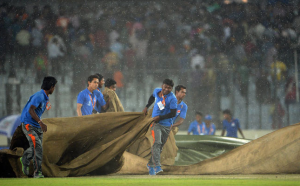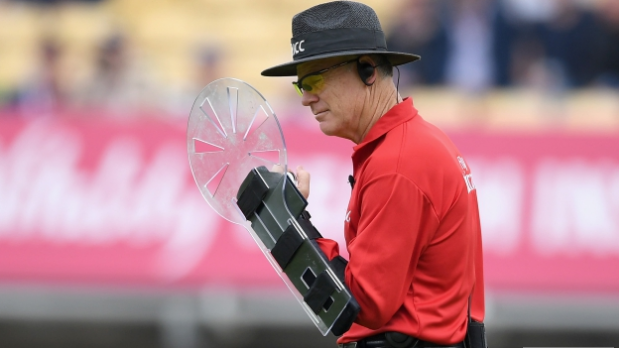Future of T20 Cricket:
I’ve been mulling over writing a piece on the future of T20 cricket for some time now, and have finally decided to bite the bullet and publish it, as I feel the game is “catching up with me” thus limiting my writing options by the day. Obviously, not all of my thoughts will be completely unique and there is every chance you will look at some of them and wonder why I have wasted my time in publishing the blindingly obvious (I’m used to this). Similarly some of my proposals will leave you with the opposite feeling, wondering if it is indeed possible to get me sectioned. Please refrain and approach this article with an open mind. After all, if a quarter of a century ago I would have told you that switch-hits, light-up stumps and relay catches would become the norm in the most popular form of cricket in the world, you would’ve laughed me all the way to Broadmoor… Brace yourselves…
The end of “Wicket Keepers” – As bizarre as this may seem on the surface, we may be a lot closer to the wicket-keeper in the traditional sense of the role, becoming a fading art and a new hybrid position taking its place. We already see slight tweaks in the role of the wicket keeper as matches wear on on in the short format, most notably with wicket keepers opting to wear only one glove in order have greater control in taking a shy at the stumps if the batsmen try to scamper a cheeky bye having missed with their initial connection. We have even seen teams taking things a step further and choose to drop the positioning of the wicket keeper to a “deep fly slip”, usually when defending a total whereby single byes are not beneficial to the batting team but edges to the third man boundary are required to be cut-off. It stands to reason that this tactic may become more common in T20 matches of the future, whereby missing out on the occasional stumping can be easily offset by saving valuable runs in fine edges in both the first innings and the chase.

Worcestershire fielding without a Wicket Keeper, T20 Blast vs Northamptonshire June 2015
A new breed of opening batsman – This is something that I touched upon in my previous article (Read Also ) wherein I praised the approach of IPL side Kolkata Knight Riders in adopting the strategy of promoting pinch hitting all-rounder (yes I’m validating him as an all-rounder from now on) Sunil Narine to the position of opener to great effect. Though not everybody is wholly convinced by this gung-ho strategy just yet, I am very confident that at the very least a variation on this theme will become commonplace, perhaps with the promotion of a typical number 4/5 batsman to take advantage of the power play, who has a slightly more seasoned batting pedigree than an all-out slogger. Fundamentally though, the point of this section is that days of batsmen wasting valuable deliveries getting their eye in whilst fielding restrictions are in place are long gone: in modern T20 cricket, every delivery counts.
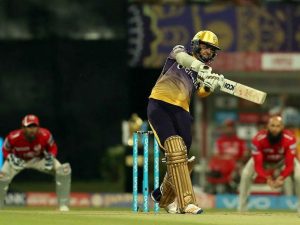
©NDTV Sports
KKR’s newest opening batsman Sunil Narine frees his arms in the powerplay vs KXIP
Variation on the orthodox batting stance – Whilst the profile and priority of T20 cricket continues to skyrocket and kids in the grass roots of their cricketing journey becoming enthralled by the bright lights of the IPL, it is only a matter of time before the “orthodox” cricket stance becomes less of a priority for coaches to instill in their students, and further unique styles are allowed to develop and flourish within the game. The current orthodox stance seeks to offer the batsman good protection for the stumps with the anticipation of a ground stroke to be played if the ball is in the right area. As the fear of a batsman losing their wicket is rapidly superseded by players seeking to maximize their ability to try to clear the rope, future styles may well offer concession to the bowlers in terms of giving them more visibility of the stumps or conversely leave batsmen hugely susceptible to LBW appeals in exchange. We have already seen some evidence of unorthodox stances coming into the game and I would suggest this is becoming more prevalent and acceptable in modern day cricket. Those currently playing the game utilizing unorthodox stances stance range from test greats like Steve Smith to short form specialists such as Colin Munro and Grant Elliott (pictured below) as well as many, many others. Good luck to the umpires making the wide calls with these stances…
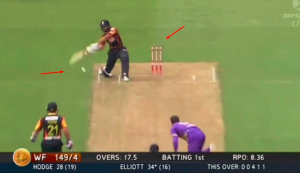
Grant Elliot countering the off stump Yorker by taking guard way outside off stump on his way to 52 (23)
Ambidextrous bowling – OK, admittedly this may be one of the more speculative predictions about the future of T20 cricket, but just think about it for a moment. We already have switch hits and reverse sweeps that serve to provide the batsmen in T20 cricket with an almost ambidextrous scope to find the rope, why then can we not bring a degree of mystery advantage back to bowlers, allowing them to deliver the ball with either hand on demand? Although this will obviously be an extremely difficult skill to procure initially, the benefits of mastering it could be significant, altering both the angle and speed of delivery in order to flummox the batsman.
Virtual Officiating – Although T20 cricket is the speediest of all formats (CEAT Tyres Strategic Timeouts aside) it makes logical sense for it to become a pioneer for the game in terms of umpiring and the smooth application of accurate video technology. Pakistan have already implemented a tidy review system within the playoff stage of their T20 product, the PSL, which gives teams the opportunity to refer one decision per innings, provided it is called for within a matter of seconds of the incident occurring. I firmly believe we will see this precedent monitored and advanced across the world and eventually changing the way we view the cricket field completely. With the growing availability of modern technology, there should be few barriers to rolling out a faultless system whereby front foot no-balls are called by an automated sensor. The use of technology should not stop there. Stumping’s, boundary calls and run-out decisions should all be able to be judged upon almost instantaneously by AI (even if they are to be initially overseen by a qualified umpire in case of obvious error). It is not beyond the realms of possibility, that in the future there will be no need for on field umpires at all. After all, who wants to see another Vitara Brezza Glam straight-drive prevented from getting to the rope by the Oxenford shield?
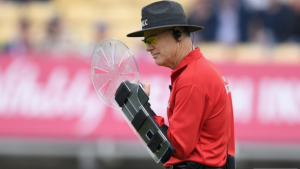
Umpire Bruce Oxenford with his protective shield
A Rainbow Tournament – With T20 leagues around the world still enforcing restrictions on the number of foreign players permitted in match day squads, a gap in the market is surely emerging for the introduction of a unique “rainbow” tournament in which these limits are lifted. Most likely, one would imagine this would be played somewhere without a traditional cricketing history, but with a desire to attract the biggest names in world sport and perhaps cultivate a growth in popularity of the game we love in the given region. Obvious examples spring to mind such as nations that have flirted with cricketing experiences in the past without forming their own, solid cricketing identities; USA and UAE (although this region has hosted competitive PSL games), however do not be surprised if there are other left-field candidates such as China vying to be the pioneer for a similar setup.

USA and UAE : The home of T20 cricket in the future?
All Weather Cricket – One of the most common grievances raised by outsiders regarding our beautiful sport, particularly having grown up on the glorious British Isles, is that it is far too dependent on the weather. No matter how delicate the situation on the field, the right amount of precipitation can put an end to the game in an instant, cruelly depriving spectators and players alike of a thrilling finale. Somehow, in the 21st century, cricket is still at the mercy of Mother Nature. It is time cricket addressed this issue in full. The idyllic solution to this is already utilized by Australian Big Bash side Melbourne Renegades, who play their home fixtures at the multi-purpose sports venue Docklands Stadium, Melbourne, which boasts the unique but useful feature of a retractable roof, enabling them to fulfill all of their fixture commitments regardless of conditions. Where this is not possible, perhaps for financial reasons, more effective drainage systems can be vital to salvaging a game, such as those recently installed at Chinnaswamy Stadium, Bangalore which went a long way to ensuring we were able to witness a finale in the IPL 10 eliminator. More accurate weather forecasting technologies should also help prepare groundsmen for the arrival of adverse weather. Just please, no more Supersoppers and Cover Wallahs doing the hokey-cokey…
